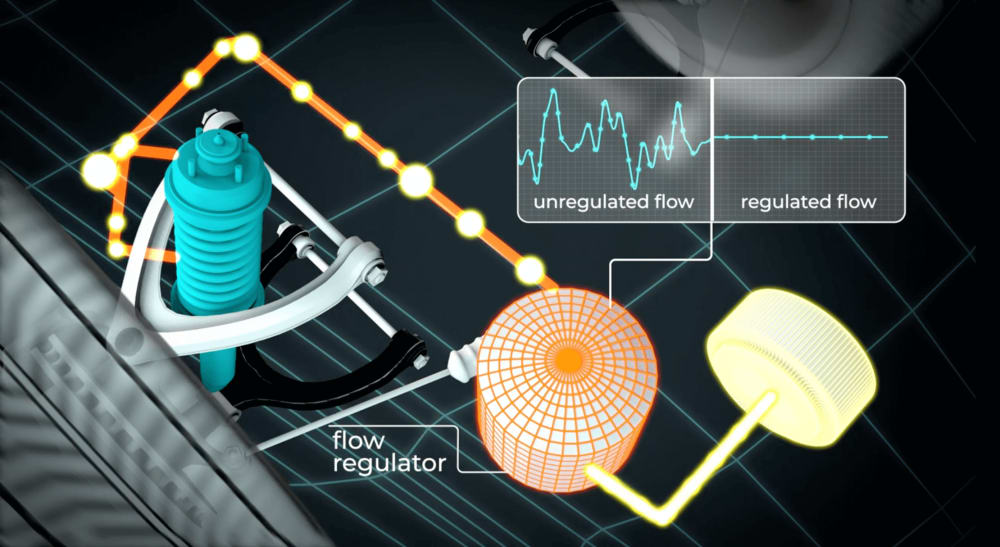The Regenerative Suspension System is a patented hydraulic technology designed to convert the mechanical motion of vehicle shock absorbers into usable electrical energy. Unlike conventional suspensions that dissipate impact forces as heat and vibration, this system harvests kinetic energy during both compression and rebound phases, providing a continuous, renewable power source to support vehicle electronics, battery recharging, or hybrid systems.
How It Works
The system interconnects all vehicle shock absorbers through a sealed fluid circuit equipped with dual one-way valves. When the vehicle moves over irregular surfaces, each plunger inside the shock absorbers displaces hydraulic fluid in a unidirectional flow. This motion occurs during both upward and downward movements, enabling bi-directional energy harvesting. Before reaching the microturbine, the fluid passes through a pulsation-regulating device composed of two independent chambers separated by a flexible membrane or plunger. One chamber contains compressed gas, which stabilizes pressure and volume fluctuations. As a result, the fluid flow becomes continuous and smooth, driving a compact turbine coupled to an alternator. The generated electricity is either used immediately within the vehicle’s electrical system or stored in onboard batteries for later consumption. After energy conversion, the fluid returns to a reserve tank, maintaining pressure balance and closing the cycle.
What Makes It Novel
This system introduces several unique advantages over existing regenerative suspension concepts:
- Bi-Directional Recovery: Unlike most designs that only harness energy in a single direction, this invention recovers energy during both compression and rebound, maximizing efficiency.
- Compact Integration: All components are designed to fit within standard hydraulic suspension architectures without requiring major structural modifications.
- Continuous Energy Production: The pulsation regulator transforms intermittent fluid pulses into a stable flow, enabling consistent turbine operation and optimized power generation.
- Versatile Application: The system can be scaled and adapted for passenger cars, heavy-duty trucks, military vehicles, agricultural equipment, and off-road platforms.
Feasibility and Manufacturing
The system relies on well-established hydraulic and electromechanical technologies. Core components—including the fluid circuit, pulsation-regulating chamber, turbine, and alternator—can be manufactured using standard automotive-grade materials such as reinforced plastics, aluminum alloys, and high-strength seals. The design is modular, facilitating integration into new vehicle platforms or retrofitting into existing suspension systems. Manufacturing processes such as precision machining, injection molding, and conventional assembly ensure cost-effective production at scale.
Applications and Market Potential
Potential markets include:
- Passenger Vehicles: Cars, SUVs, and vans requiring improved energy efficiency.
- Commercial Transportation: Buses and trucks with high daily mileage, where energy recovery contributes to operating cost reduction.
- Electric and Hybrid Vehicles: Platforms seeking to extend driving range and optimize battery charging through regenerative systems.
- Military and Tactical Vehicles: Applications in demanding environments where auxiliary power increases autonomy.
- Agricultural and Construction Equipment: Heavy machinery benefiting from additional onboard electricity generation.
The growing emphasis on sustainable mobility, reduced emissions, and energy optimization creates a clear demand for such solutions. The Regenerative Suspension System provides a practical and innovative path to transform passive suspension into an active energy source, positioning vehicle manufacturers and suppliers to lead in the next generation of intelligent, energy-efficient transportation.
Video
Like this entry?
-
About the Entrant
- Name:Antonio Garcia Lopez
- Type of entry:individual








